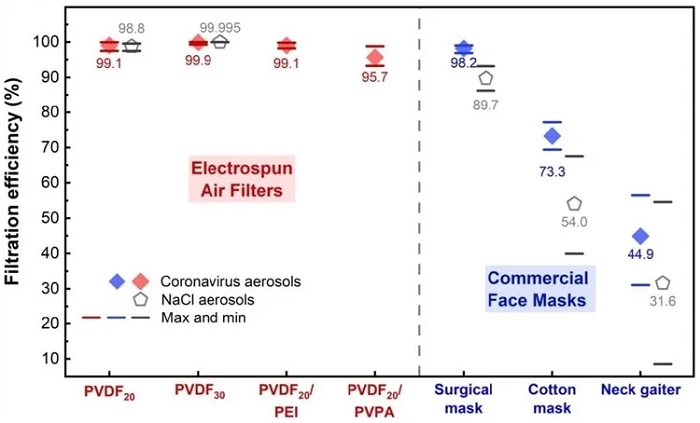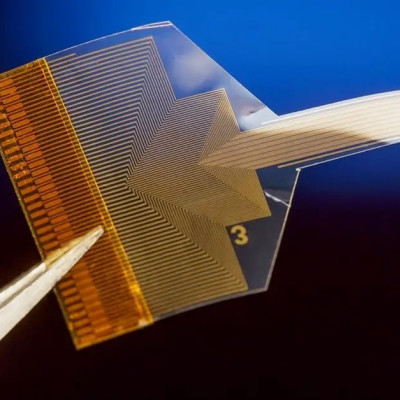The spread of the virus in aerosol droplets is most infectious through long-range transmission; the half-life of SARS-CoV-2 in aerosols is 1.1 hours. One of the major mitigation strategies in the spread of the novel coronavirus, then, has been the use of face masks. For the pandemic, many types of masks have hit the market with varying levels of effectiveness.
A mask's pore size is critical in its effectiveness in preventing infection – generally, there are a couple of microns in surgical masks and tens to hundreds of microns in cloth masks. The electrospun air filters, due to their ultrafine nanofibers (~300 nm), have a very small pore size comparatively. Electrospun nanofibrous membranes are also excellent for removing aerosols (polystyrene beads, NaCl, and bacteria).
A US-based research team from The George Washington University and the University of California Riverside designed and fabricated electrospun nanofibrous air filters that hold promise for applications in personal protective equipment and indoor environments. The team compared the filtration efficiency of coronavirus and NaCl aerosols to a broad spectrum of electrospun air filters and face masks.
They developed advanced electrospun air filters for capturing coronavirus aerosols – showing an excellent performance of up to 99.9%. They show that these filters outperform many commercially available face masks.
Thus, in this study, they also show for the first time that NaCl is an eligible surrogate for coronavirus during aerosol filtration tests.
Electrospinning is a new technology to synthesize non-woven nanofibrous membranes that are ideal for air filtration. Here, a polymer solution is ejected into a strong electric field to form fine nanofibers having reduced pore size. This enables the effective capture of small airborne particles.
The fiber diameter of the electrospun filters used in this study ranges between 0.2-1.3 microns. The electrospun filters had a mean pore size ≤ 2.7 microns, whereas all the commercial masks had a mean pore size ≥ 17.5 microns.
Because the electrospinning operates under a strong electric field (i.e., 1-5 kV cm-1), the filters retain surface and volume charges that significantly promotes aerosol capture through electrostatic attraction.
For the filtration tests, NaCl aerosols are widely used. In this study, the team compared the filtration efficiency obtained from the coronavirus aerosols and the NaCl aerosols.
The team selected Murine hepatitis virus A59 (MHVA59), a coronavirus in the same family as SARS-CoV-2, for aerosol generation and filtration. They demonstrated that the NaCl aerosols are an eligible surrogate for the coronavirus aerosols in the filtration tests when air filters and face masks with diverse pore sizes, morphologies, and efficiencies were used.
The authors claim that this is the first study of this kind: evaluating the filtration efficiency of the air filters/face masks by using aerosols of a coronavirus rather than surrogates.
Our work paves a new avenue for advancing air filtration by developing electrospun nanofibrous air filters for controlling SARS-CoV-2 airborne transmission."
This study demonstrates that electrospun air filters formed by nanofibres hold promise for providing efficient protection against airborne coronavirus particles. Developing electrospun air filters for capturing viral aerosols is still in its nascent stage; this indicative study shows a significant move forward.

Aerosol filtration efficiency of electrospun air filters and commercial face masks. Aerosols generated from coronavirus (MHV-A59) and NaCl were used for tests. Red and blue diamonds represent the average filtration efficiency of MHV-A59 aerosols by the electrospun air filters and the commercial face masks, respectively. Gray pentagon represents the average filtration efficiency of NaCl aerosols. Red, blue, and gray bars represent max and min values of the filtration efficiency in replicates.
This study has validated the eligibility of NaCl as a surrogate of coronavirus in aerosol filtration tests by comparing the filtration efficiency for a broad spectrum of air filters and face masks with different pore sizes and ranges of efficiency.
Most air filters used in residential, commercial, and industrial buildings – except high-efficiency particulate air (HEPA) filters – used in healthcare facilities only capture larger particles like dust, mold spores, or bacteria but not airborne viruses. The need of the hour – an innovative and efficient air filter for the HVAC system that can prevent the long-range transmission and accumulation of coronavirus aerosols – is addressed in this study.
Nanotechnology holds promise for developing effective, scalable, and affordable air filters for both mask/respirator and HVAC system applications."
Read the original article on Medical News.







